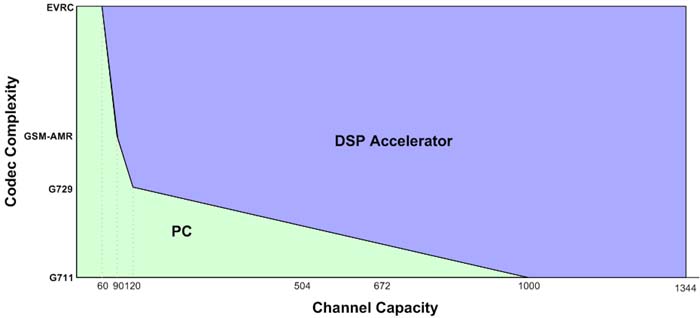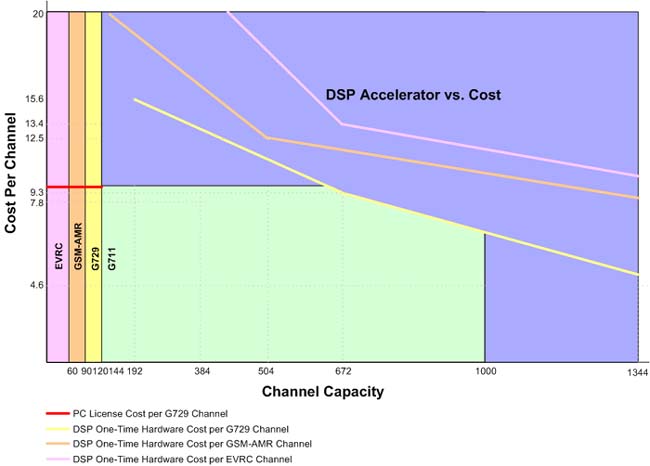HMP vs. DSP Tradeoffs
At low channel capacities, the HMP model is effective. As channel capacities
increase, tradeoffs often lead to adding a "DSP accelerator" -- some type of add-in
hardware that substantially increases the capacity of each server. When considering
the "cross over point" at which to scale an HMP platform with a hardware add-on, there
are some useful tradeoffs to keep in mind:
1) Channel Capacity. PC/server platforms have limited video and
voice processing capability. As channel capacities increase, a
cross-over region exists where a choice must be made to either
add more servers or use a DSP accelerator. The cross-over point
is reached sooner depending on the nature of the processing -- for
example, for VoIP impacting factors include the type of voice
codec (e.g. G729, G723, GSM-AMR, EVRC, etc), length of echo
cancellation tail (if needed), and voice quality monitoring (also
if needed).
Below is a curve showing HMP vs. DSP cross-over regions for a VoIP
application, with codec processing complexity on the vertical axis
and channel capacity on the horizontal axis.
The above graph shows HMP-to-DSP crossover for an approximate 3 GHz,
dual Xeon machine.
2) Per Channel Cost. At low channel capacities, HMP is far more
cost-effective than DSP. For simple G711 VoIP processing, a DSP
accelerator is not required until the number of channels hits a limit
in the 500 to 1500 channel range, reducing cost per channel to "zero"
if one assumes the PC platform has to be there anyway and is an
inherent cost. But for more complex processing -- or for algorithms
which have significant associated licensing cost -- the cost per
channel can be high.
The graph below gives some idea of typical cost per channel figures for
a DSP solution.
The above graph assumes the cost of the first HMP server itself is
"free"; i.e. the server has to be there anyway to act as a host
platform, and assumes about a $10/channel cost for HMP server
licensing cost for "complex" codecs such as G729, GSM-AMR, etc.
3) IP rights cost must be considered. For example, when a VoIP application requires
100 or more G729 or EVRC channels on an HMP platform, who pays the $1000+ per system
royalty cost? DSPs typically embed IP rights cost within the individual chip cost.
Semiconductor suppliers like Texas Instruments often possess leverage to make
favorable IP licensing deals due to their patent portfolio and cross-licensing
options. How many voice and video codec patents does Intel have compared to TI,
Qualcomm, etc? A quiet submarine is not achieved without practicing for decades.
Intel has not done that; the DSP vendors have.
4) Power Consumption. Power consumption and "system wide complexity" costs rise exponentially with HMP servers. Doubling the number of HMP servers more than doubles "latent costs" such
as power consumption because more than half the electricity cost of an HMP server is
wasted in voice and video applications. As the number of HMP servers increases, more electricity is wasted, both in terms of duplicated functions
and in terms of cooling. Likewise, maintenance cost increases
and MTBF decreases with more cabling, more fans, more power cords, etc. Foreseeable Future
Will more powerful CPUs ever displace DSPs? A simple way to look at this is that
Intel/AMD x86 processors -- in order to provide legacy software support and make
their host systems standardized and easy to use -- must contain millions of
transistors to support Windows and Linux motherboards. More than 80% of these
transistors are wasted when the x86 is asked to perform voice and video processing.
This is the "Intel penalty" for monopolizing the PC/server motherboard market. The
conclusion is straightforward: for the foreseeable future, DSP and FPGA vendors will
continue to exploit this inefficiency, and DSP hardware acceleration will continue to
play a key role in scalable HMP platforms.
Multi-Core VoIP
On a single half-size PCI VoIP card Signalogic has been able to place 72 cores, 600 MHz
each, with total power consumption of only 23 W; with no heatsinks required. In terms of
raw number of cores, the closest x86 solution is a Tyan "Super PC" with 40
cores. In terms of power consumption, there is no x86 solution remotely
comparable.





